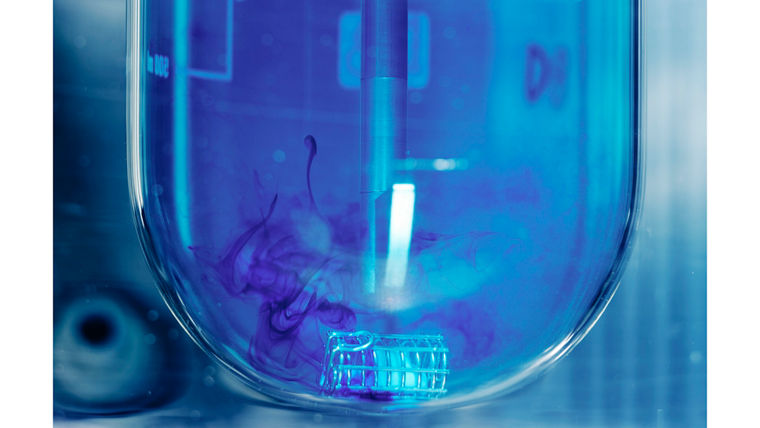The equipment looks like an oversized washing machine: A drum rotates slowly behind the round window in the rectangular housing. It holds 56 liters and spins 30,000 white capsules like those we know from medications. A fine mist spraying from two nozzles is barely visible as it applies a coating to the capsules. It’s pretty loud in this room on the ground floor of an Evonik laboratory at the Darmstadt site. That’s why chemical laboratory technician Peter Niepoth is standing in the next room and monitoring the process through a pane of glass. As Innovation Project Manager, he is responsible for technical implementation during the development of Eudracap colon—the capsule that’s visible next door.
“The sprayed suspension should not form drops that are too large, because then the capsules will stick together. But the drops should not be too small either, because then the spray mist will be dried by the process air before it hits the capsule,” says Niepoth, explaining the challenge.
The coating turns a simple cellulose capsule into a high-tech mode of transport that enables completely new treatment methods in medicine. Thanks to Eudracap colon, sensitive biologics such as biotechnologically produced proteins and peptides, RNA therapeutics, and living microorganisms that alter intestinal flora can be reliably delivered through the stomach and released only when they reach the colon, where they are most effective.

Intestinal cancer or intestinal infections and chronic diseases such as ulcerative colitis or Crohn’s disease could be treated in this way. Active ingredients for numerous other serious diseases would also be optimally absorbed via the mucous membrane of the large intestine if they could get there—including drugs for Parkinson’s, Alzheimer’s, diabetes, obesity, and chronic pain. Until now, the lack of oral administration options has meant that patients have usually had to resort to injections, which can be time-consuming and unpleasant.
ELEMENTS-Newsletter
Get exciting insights into Evonik's research and its societal relevance – conveniently delivered to your inbox via email.
Huge market potential
Eudracap colon makes it possible to conveniently administer active pharmaceutical ingredients, also known as APIs or actives, against all these diseases in the form of capsules. More than 750 drug candidates for oral application in the areas of the microbiome, oligonucleotides, and biologics are currently in clinical development.
Product Manager Dr. Bettina Hölzer describes the timing of the development of Eudracap colon as a “stroke of luck”. “When we evaluated the market potential for such a capsule a few years ago, it was clear that there was a need for this product,” she recalls. But a lot has happened during its development, and the size of this market is now much bigger than we expected.”

The covid-19 vaccination, for example, drew unexpected attention to RNA technology. Since then, the development of RNA active ingredients has been booming. Until now, these have almost always had to be injected. Research into the intestinal microbiome and bacterial strains as a therapeutic approach has also increased significantly. It opens up treatment options that no one would have thought possible ten years ago.
In addition, the pharmaceutical industry has great interest in oral biologics such as GLP-1 receptor agonists, which among other things help to regulate blood sugar levels and gastric emptying. Most recently, the injectable weight loss drug Wegovy has even made such peptide active ingredients popular in the lifestyle sector.
Eudracap colon builds on 70 years of success: That’s how long pharmaceutical manufacturers in particular have been using the functional polymer Eudragit from Evonik as a coating to pass tablets, pellets, particles or capsules made of gelatine or hydroxypropyl methylcellulose (HPMC) through the stomach. If left uncoated, these dosage forms would be broken down by gastric acid and enzymes and release the active ingredient too early. However, classic Eudragit technology is only suitable for actives that can withstand the coating process.

Sensitive freight
This does not include therapies that use bacteria to change the gut microbiome. The microorganisms cannot be compressed into tablets because the pressure, humidity, and heat would kill them. “The classic alternative would be to fill and coat an HPMC capsule so that it passes safely through the stomach,” says Hölzer. However, the bacteria cannot survive the heat and mechanical stress associated with a coating process either. The situation is similar for peptides and RNA, which must be protected from digestive enzymes in the stomach. However, just like bacteria, peptides and RNA often do not withstand the coating process. That’s why a solution that protects the active ingredient and safely transports it into the large intestine had to be found.

“The obvious idea was to functionalize a pre-locked HPMC capsule with Eudragit,” recalls Hölzer. “The manufacturer of the active ingredient could then open the capsule, fill it with its active ingredient, and, finally, close it again.” However, this sounds easier than it actually is. If the empty capsule were to open during the coating process, there would be a risk that it would deform and the halves would no longer fit together. However, if the capsule was completely coated, it could no longer be opened easily to fill it. And if the coating had an interruption in the area of the gap, the protection against stomach acid and enzymes would not work reliably.

»The size of the market for functionalized capsules exceeds our expectations«
Bettina Hölzer Product Manager Eudracap
“Initially, my biggest concern was whether our idea could be implemented on a commercial scale,” says Hölzer. But this concern proved to be unfounded: A pre-locked capsule falling apart during the coating process remains the exception thanks to technical countermeasures. Thanks to its many years of experience with coating processes, the team was also able to master the challenge of ensuring a seamless coating after the final closing of the capsule.
The most important part of the solution was to spray the suspension homogeneously in exactly the right thickness: thin enough that the capsule can be opened and closed again easily; thick enough that the layer in the gap compresses when closed and seals it without gaps. The team was in for a pleasant surprise: Upscaling, i.e. increasing the number of units, made the coating for Eudracap colon even more homogeneous.

Lower costs, faster pace
For pharmaceutical companies, the pre-coated and pre-locked capsule has advantages in both the development and manufacturing process. “The capsules are functionalized containers. This means that a complex formulation no longer needs to be developed to transport the active ingredient through the digestive tract,” says Hölzer. “This reduces development and production costs and shortens the time to market for the new drug.” In addition, the pre-coated Eudracap capsules can be filled in the pharmaceutical companies’ factories using the existing machines that are also used for other capsules. As the filled capsule no longer needs to be coated, customers can eliminate an entire additional process step.

The project team had thus solved one of the two major problems. The second challenge was to ensure that the active ingredient was really only released in the large intestine. This is because acids and enzymes in the preceding regions of the digestive tract break down most of the active ingredients before they can be absorbed. In addition, only the large intestine offers the possibility of absorbing active ingredients evenly over a longer period of time.
Through the body

Basically, the capsule is functionalized with a special polymer mix so that it only dissolves above a certain pH. This is because the pH normally rises steadily from the stomach, where it is between 1 and 5, depending on the level of saturation due to the digestive juices. In healthy people, the pH in the small intestine is around pH 5.5 and only in the large intestine does the pH exceed 7.0.
“However, the pH in the intestine is often somewhat lower in patients with intestinal diseases,” explains Hölzer. The team therefore had to take another factor into account: the mechanical pressure loads in the digestive tract. Laboratory tests that simulate both the pH curve and mechanical stress helped to develop a solution that ensures the release of the active ingredient in the large intestine. Peptides and RNA are optimally absorbed there and microorganisms find the ideal place to colonize.
“But are we hitting the exact point we want to reach?” asks Niepoth. To ensure this, the team analyzed the release of the active ingredients on two similar devices.

The first device, a disintegration tester, is located on the ground floor of the Darmstadt laboratory. Several transparent vessels are lowered into a water tank. Inside the vessels are tubes, each containing a capsule. A small weight on the capsule, known as a disc, acts as a sensor. An arm that moves up and down keeps the capsule and liquid in motion, simulating transportation in the digestive tract.
“We set different pH values in the vessels as well as a temperature that corresponds to that of the human body,” explains Niepoth. At pH 1.0, the capsule should not disintegrate even after two hours. And the entire filling should only be released in no more than one hour when pH 7.2 is reached. When this happens, the capsule first softens and then disintegrates. The sensor sinks to the ground and triggers a signal: Once the capsule has completely disintegrated, timing is stopped.
On the path to application
One floor up, a dissolution tester with an optical sensor measures how much of the content has already been released into the solution. “Initially, we used both devices to develop the right coating,” explains Niepoth. Now that development is complete, this floor is used to carry out quality control. The capsules are filled manually, either in a single holder with a funnel or using a board that can process 30 to 50 capsules at a time. In commercial production, this step is automated: A small production machine needs less than an hour to produce several tens of thousands of capsules.
Eudracap colon has been available for animal studies and laboratory tests since September 2024 and should also be available as an IPEC-GMP-certified product by the end of this year—a prerequisite for its use in human medicine. A sister product is already further along: Eudracap enteric has the same properties, but the coating is adjusted so that the capsule releases the active ingredient in the upper small intestine.
“For Eudracap enteric, we have a customer whose therapeutic is already in Phase III clinical development—the last stage before approval. After Phase II, this customer decided to switch to our capsules and achieved better results than with anything else on the market to date,” says Hölzer.

Another customer reports that thanks to the Evonik capsule, around 90 percent of the filled bacteria survive the passage through the stomach. This figure was significantly lower with the previously used method. Both customers’ products are designed to treat infections with Clostridium difficile, a bacterium that is resistant to many antibiotics and can cause abdominal pain and diarrhea, which can be fatal in the worst cases. Hölzer is particularly pleased that one customer is based in Europe, while another is in the United States. “This means that the two key regulatory authorities are already familiar with Eudracap,” she says.
A third platform is called Eudracap Select. “This enables us to meet customer-specific requirements,” explains Hölzer. If, for example, a different pH is required for the dissolution, the polymer mixture can be adjusted. Different capsule sizes are also possible. “In addition, the capsules not only safely transport microorganisms, peptides, and RNA to their targets, they can also be filled with any conceivable active ingredient,” reports Hölzer. Now that the technical development of Eudracap colon is finished, the team can turn its attention to new projects. Hölzer says “There are still no satisfactory formulations and dosage forms for many of today’s treatments. This is where we come in.”

Evonik wins CPHI award
Evonik won the CPHI Excellence in Pharma Award in the "Finished Formulation" category with EUDRACAP colon on October 29, 2025. "We are incredibly proud that EUDRACAP colon has been recognized with a CPHI Award. By offering a solution for sensitive active ingredients while simplifying formulation development and enabling faster clinical entry, EUDRACAP colon will help bring groundbreaking therapies to patients more quickly," said Thilo Krapfl, Head of Oral Drug Delivery Solutions at Evonik Health Care.
EUDRACAP colon was developed to enable the safe and effective oral delivery of sensitive active pharmaceutical ingredients (APIs) such as live biotherapeutic products (LBPs), RNA, and biologics. These APIs are used in the formulation of innovative medicines for treating conditions such as obesity, HIV, or cystic fibrosis, as well as for local delivery, for example, in colorectal cancer and infections. Currently, there are more than 700 programs focused on developing oral drugs with novel active ingredients. In fact, these new drug candidates account for about one-third of all new oral drug developments in the pipeline.
"This innovation is more than just a technical achievement—EUDRACAP colon provides a unique solution for delivering sensitive APIs that simply could not be formulated otherwise without the risk of damage or degradation," said Dr. Bettina Hölzer, Global Product Manager for Oral Drug Delivery Solutions at Evonik Health Care.
EUDRACAP colon is the latest innovation in Evonik's growing portfolio of functional capsules for oral drug delivery. This portfolio includes EUDRACAP enteric for targeted drug release in the upper small intestine, EUDRACAP Select for customized CDMO services, and EUDRACAP preclinic for early development stages. The functional capsule platform is built on the proven foundation of EUDRAGIT polymers, which are used in formulations across 80 countries and cited in over 23,000 patents.




